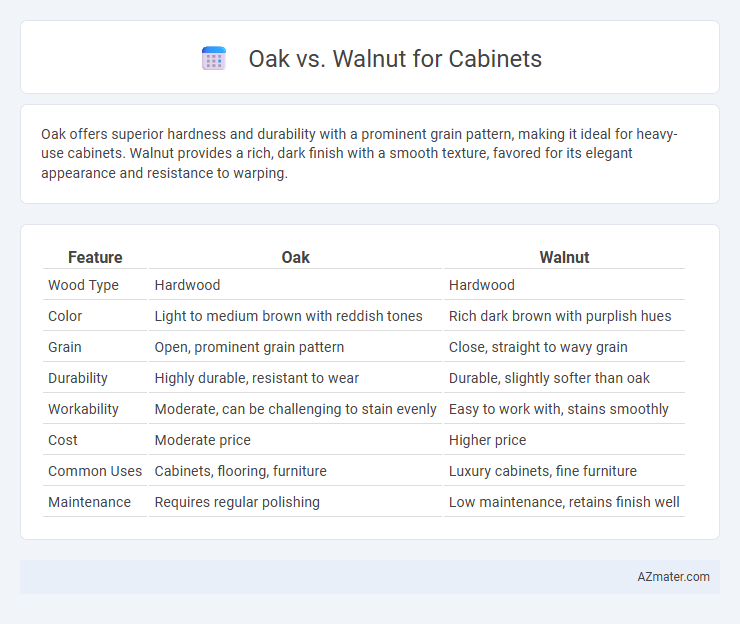Oak offers superior hardness and durability with a prominent grain pattern, making it ideal for heavy-use cabinets. Walnut provides a rich, dark finish with a smooth texture, favored for its elegant appearance and resistance to warping.
Table of Comparison
| Feature | Oak | Walnut |
|---|---|---|
| Wood Type | Hardwood | Hardwood |
| Color | Light to medium brown with reddish tones | Rich dark brown with purplish hues |
| Grain | Open, prominent grain pattern | Close, straight to wavy grain |
| Durability | Highly durable, resistant to wear | Durable, slightly softer than oak |
| Workability | Moderate, can be challenging to stain evenly | Easy to work with, stains smoothly |
| Cost | Moderate price | Higher price |
| Common Uses | Cabinets, flooring, furniture | Luxury cabinets, fine furniture |
| Maintenance | Requires regular polishing | Low maintenance, retains finish well |
Introduction to Oak and Walnut Cabinets
Oak cabinets showcase a durable hardwood known for its prominent grain patterns and warm tones, making it a popular choice in traditional and rustic kitchen designs. Walnut cabinets offer a rich, dark brown color with smooth, straight grain and exceptional stability, favored for luxurious and modern cabinetry. Both woods provide long-lasting quality and natural beauty, with oak emphasizing strength and grain contrast, while walnut highlights elegance and a sophisticated finish.
Appearance and Grain Differences
Oak cabinets exhibit a prominent, coarse grain pattern with a slightly textured surface, often showcasing light to medium brown hues with occasional reddish undertones. Walnut cabinetry features a smoother grain with a fine, straight or wavy pattern, characterized by rich, deep chocolate brown colors that may include purples or smoky gray highlights. While oak offers a traditional, rustic aesthetic, walnut provides a more elegant and sophisticated appearance, making grain and color key deciding factors for cabinet selection.
Durability and Strength Comparison
Oak cabinets provide exceptional durability and strength due to their dense grain structure and hardness rating of 1290 on the Janka scale, making them highly resistant to dents and wear. Walnut, although slightly softer with a Janka hardness of 1010, offers strong structural integrity combined with its natural resistance to warping and cracking, ideal for long-lasting cabinetry. Both hardwoods deliver reliable performance, but oak outperforms walnut in toughness and impact resistance, ensuring greater longevity in high-traffic kitchen environments.
Color Options and Staining Potential
Oak offers a wide range of color options from light beige to medium brown, with prominent grain patterns that absorb stain evenly, enhancing its natural texture. Walnut features rich, dark brown hues with occasional purple or gray undertones and responds well to light staining, allowing its deep, luxurious tones to remain visible. Both woods provide excellent staining potential, but oak's open grain absorbs stain more uniformly, while walnut's dense grain retains more of its natural color.
Cost Analysis: Oak vs Walnut
Oak cabinets typically cost between $150 to $300 per linear foot, offering a more budget-friendly option compared to walnut, which ranges from $250 to $600 per linear foot due to its premium quality and richness. The price difference is influenced by the availability, grain pattern, and durability, with walnut being harder and more resistant to wear but significantly more expensive. Choosing oak provides a cost-effective solution for hardwood cabinets without compromising on strength, while walnut suits high-end designs where luxury and aesthetic depth justify the higher investment.
Ease of Maintenance and Cleaning
Oak cabinets are highly durable and resistant to dents and scratches, making them easier to maintain with routine dusting and gentle cleaning using mild soap and water. Walnut cabinets require more careful upkeep due to their softer wood fibers and darker finish, which can show fingerprints and smudges more prominently, necessitating frequent wiping with a soft cloth to preserve their rich appearance. Both wood types benefit from regular application of wood conditioner or oil to maintain luster and prevent drying or cracking, but oak offers a more forgiving surface for busy kitchens or high-traffic areas.
Popular Cabinet Styles for Each Wood
Oak cabinets showcase popular styles such as traditional, farmhouse, and Mission, prized for their prominent grain patterns and durability. Walnut cabinets excel in modern, mid-century, and contemporary styles, offering rich, dark tones and smooth textures. Both woods provide distinct aesthetic qualities that suit different design preferences and interior themes.
Environmental Impact and Sustainability
Oak cabinets are known for their fast growth rate and widespread availability, making them a more sustainable choice due to shorter harvesting cycles and reduced deforestation risks. Walnut grows slower and is less abundant, which can contribute to higher environmental pressure from logging and longer regeneration periods. Choosing oak over walnut supports better forest management practices and lowers the ecological footprint associated with cabinet production.
Best Uses and Room Suitability
Oak cabinets excel in durability and moisture resistance, making them ideal for kitchens and bathrooms where humidity is high. Walnut, with its rich, dark tones and fine grain, suits living rooms and dining areas that benefit from a warm, luxurious aesthetic. Choosing oak supports a rustic or traditional style, while walnut complements modern and elegant interior designs.
Final Verdict: Choosing Oak or Walnut for Cabinets
Oak cabinets offer exceptional durability and a classic, grain-rich appearance perfect for traditional and rustic designs, while walnut brings a luxurious, darker tone with smooth grain lines ideal for modern and elegant interiors. Budget-conscious projects benefit from oak's affordability and availability, whereas walnut suits high-end applications due to its premium cost and sophisticated aesthetic. The final choice depends on desired style, budget constraints, and long-term durability requirements for cabinet installations.

Infographic: Oak vs Walnut for Cabinet
 azmater.com
azmater.com